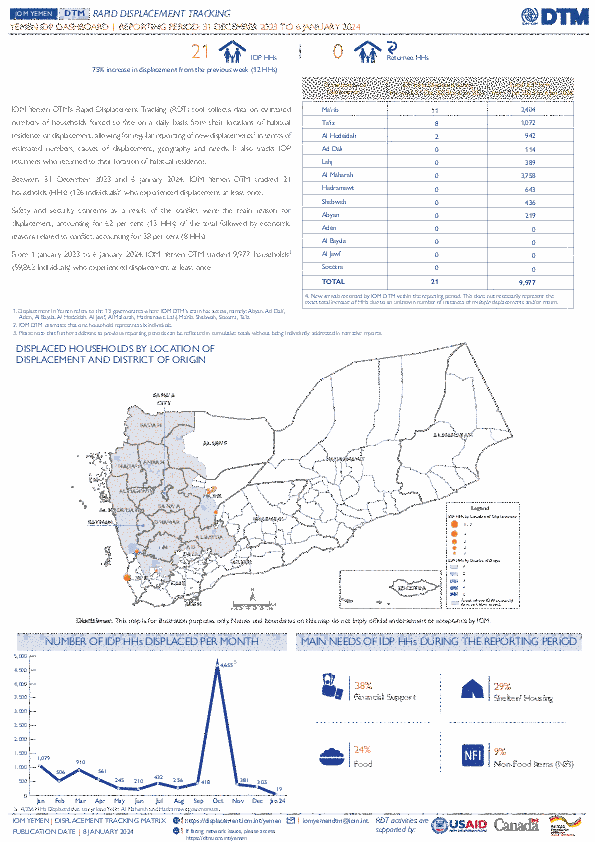-
Countries
-
Data and Analysis
-
Special Focus
-
Crisis Responses
Yemen — Rapid Displacement Tracking Update (31 December 2023 - 06 January 2024)

Contact
iomyemendtm@iom.int
Language
English
Location
Yemen
Period Covered
Dec 31 2023
Jan 06 2024
Activity
- Mobility Tracking
- Event Tracking
IOM Yemen DTM’s Rapid Displacement Tracking (RDT) tool collects data on estimated numbers of households forced to flee on a daily basis from their locations of origin or displacement, allowing for regular reporting of new displacements in terms of estimated numbers, geography, and needs. It also tracks returnees who returned to their location of origin.
From 1 January 2023 to 6 January 2024, IOM Yemen DTM tracked 9,977 households (HH) (59,862 Individuals) who experienced displacement at least once.
Between 31 December 2023 and 6 January 2024, IOM Yemen DTM tracked 21 households (126 individuals) displaced at least once. The majority of people moved into/within the following governorates and districts:
- Ma’rib (11 HHs) – Marib (5 HHs), Marib City (4 HHs), Harib (2 HHs) districts. Most displacements in the governorate originated from Marib and Al Hodeidah.
- Ta’iz (8 HHs) – Al Makha (7 HHs) district, Al Misrakh (1 HH). Most displacements in the governorate originated from Taiz and Al Hodeidah.
- Al Hodeidah (2 HHs) – Hays (2 HHs) district. All displacements in the governorate were internal.
The majority of people moved from the following governorates and districts:
- Al Hodeidah (8 HHs) – Hays (4 HHs), Al Jarrahi (2 HHs), Al Marawiah (1 HHs) districts.
- Ta’iz (4 HHs) – Al Misrakh (4 HHs) district.
- Ma’rib (4 HHs) – Jabal Murad (2 HHs), Al Jubah (1 HHs), Harib (1 HHs) districts.
IOM identified 28 households displaced in the previous reporting period, which covered 24 - 30 December 2023, in the governorates of Al Hodeidah (18 HHs) and Ma’rib (10 HHs). These figures have been added to the cumulative displacement total recorded since the beginning of the year.
